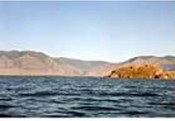
Baikal mysteries unraveled in library collections
A Russian holiday, Baikal Day, was established in 1999 and since then has been celebrated annually on the fourth Sunday of August. The value of the lake as a phenomenon is recognized all over the world, and the collection of the Presidential Library, through regional partners, is enriched from year to year by the documents that prove the fact.
Unique properties of Baikal have interested the humanity for a long time, but it was Russian scientists who first began its research, their expeditions were often held in extreme conditions, but the materials they obtained later made basis for many scientific theories and discoveries in various fields of knowledge. One of the pioneers in learning the Lake Baikal was Ivan Dementievich Chersky. His contribution to the study of Siberia is covered by several rare books stored in digital form at the Presidential Library.
The scholar set out to unravel the mystery of the origin of Lake Baikal. Chersky and his associates had contributed in clarifying the issue. In their works they noted that ordinary life of the lake lasts for about 10-15 000 years, then it disappears, silting, filled with sediments. Baikal, which arose on the site of tectonic break 25 million years ago, does not show any sign of aging.
The fact that the nature has carried this wonderful creation through millions of years of evolution prompted scientists to think that Lake Baikal is not just a lake, but a germ of the ocean. In any case, the Baikal shores slide apart 2 cm per year. This is stated in the book byIvan Chersky, "On the results of the study of Lake Baikal" of 1886; along with the book, geological survey maps also make part of digital collections of the Presidential Library.

